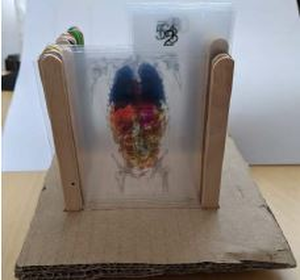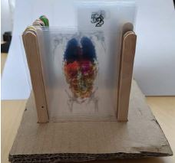Information
- Publication Type: Master Thesis
- Workgroup(s)/Project(s):
- Date: 2020-22-24
- Date (Start): 12. January 2020
- Date (End): 24. November 2020
- Second Supervisor: Hsiang-Yun Wu

- Diploma Examination: 29. November 2020
- Open Access: yes
- First Supervisor: Eduard Gröller

- Pages: 131
- Keywords: Phyiscalizations, Anatomy Education
Abstract
Long before the onset of computer technology, anatomical sculptures were already used for educational purposes. Digital imaging technology and its incorporation into the clinical workflow through the advancements of medical visualization led to a steady decline in the use of sculpture-based teaching aids. Currently, anatomical volume visualizations are predominantly presented on computer screens. Recent developments in augmented, mixed, and virtual reality o˙er new, exciting ways to digitally display medical imaging data. In recent years, the application of real-world sculptures to display patient imaging data has seen a resurgence through the field of data physicalization. Predominantly, it has been used to enhance the education of medical personnel and laymen through the use of physical models. Expensive 3D printing technology is often employed in the creation of high fidelity anatomical sculptures, with realistic look-and-feel. However, few approaches make use of a˙ordable physicalizations in the field of layman anatomical education.
In the course of this thesis di˙erent ways to introduce self-made, custom physical-izations into layman medical education are explored. We propose a suitable concept, the Vologram, to display medical volume data in a visually appealing way for medical non-experts. This takes the form of slide-based sculptures, made out of a˙ordable ma-terials available to the general public with a high degree of interactivity, and can be produced through commonly available means. To support a customizable workflow in the creation of these sculptures, we provide a stand-alone desktop application, which allows layman users to create custom educational sculptures. Real medical imaging data can be filtered and displayed in di˙erent ways, delivering optically diverse results. We evaluate the concept in a small scale study, to determine the e˙ect of interactive medical visualizations as opposed to physicalizations on the target audience. The results of this study point to a great potential for the application of interactive educational concepts for layman anatomical education.
Additional Files and Images
Additional images and videos
Additional files
Weblinks
BibTeX
@mastersthesis{Pahr2020,
title = "Vologram: Educational Craftworks for Volume Physicalization",
author = "Daniel Pahr",
year = "2020-22-24",
abstract = "Long before the onset of computer technology, anatomical
sculptures were already used for educational purposes.
Digital imaging technology and its incorporation into the
clinical workflow through the advancements of medical
visualization led to a steady decline in the use of
sculpture-based teaching aids. Currently, anatomical volume
visualizations are predominantly presented on computer
screens. Recent developments in augmented, mixed, and
virtual reality o˙er new, exciting ways to digitally
display medical imaging data. In recent years, the
application of real-world sculptures to display patient
imaging data has seen a resurgence through the field of data
physicalization. Predominantly, it has been used to enhance
the education of medical personnel and laymen through the
use of physical models. Expensive 3D printing technology is
often employed in the creation of high fidelity anatomical
sculptures, with realistic look-and-feel. However, few
approaches make use of a˙ordable physicalizations in the
field of layman anatomical education. In the course of this
thesis di˙erent ways to introduce self-made, custom
physical-izations into layman medical education are
explored. We propose a suitable concept, the Vologram, to
display medical volume data in a visually appealing way for
medical non-experts. This takes the form of slide-based
sculptures, made out of a˙ordable ma-terials available to
the general public with a high degree of interactivity, and
can be produced through commonly available means. To support
a customizable workflow in the creation of these sculptures,
we provide a stand-alone desktop application, which allows
layman users to create custom educational sculptures. Real
medical imaging data can be filtered and displayed in
di˙erent ways, delivering optically diverse results. We
evaluate the concept in a small scale study, to determine
the e˙ect of interactive medical visualizations as opposed
to physicalizations on the target audience. The results of
this study point to a great potential for the application of
interactive educational concepts for layman anatomical
education.",
month = ,
pages = "131",
address = "Favoritenstrasse 9-11/E193-02, A-1040 Vienna, Austria",
school = "Research Unit of Computer Graphics, Institute of Visual
Computing and Human-Centered Technology, Faculty of
Informatics, TU Wien",
keywords = "Phyiscalizations, Anatomy Education",
URL = "https://www.cg.tuwien.ac.at/research/publications/2020/Pahr2020/",
}


 Image
Image Master Thesis
Master Thesis Poster
Poster

